“Please Give Me A Sign”
A prayer in Istanbul’s Blue Mosque
leads a young Christian to Lord Krsna.
by Visakha-devi dasi
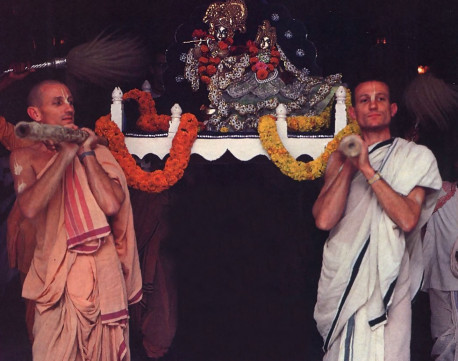
John, a slight, fair-complexioned traveler who’d left home to broaden his perspective on life, found himself stranded in Istanbul. With nothing to do until money arrived from a friend, he’d gone to the magnificent Blue Mosque, an awe-inspiring monument with huge stained-glass windows, to offer a sincere prayer to God—the first such prayer of his life.
The devout Moslems were used to sightseers visiting their mosque, but they were surprised to see this young man kneeling as they did, with outstretched arms and palms turned upward. While growing up in London, John hadn’t concerned himself with the once-a-week affair of religion, but throughout ten months of travel he’d been moved by the God consciousness of people’s lives. While in India, he’d heard worshipers of Siva, Visnu, Durga, and Buddha declare their god supreme; in Europe Jesus was the only way; and now in Turkey it was Allah. In his mind John had resolved the conflicting beliefs by deciding, “God is the creator.” And so on that clear winter’s morning he prayed, “O almighty creator, if there is a God, there can only be one. And if You are there, please give me a sign.”
Living simply, carrying only a few possessions, abstaining from drugs and other intoxicants, and making friends as he went, John had lived simply as he traveled. After his prayer he continued in that way, but his perception changed. He saw that God was fulfilling his desires, protecting and providing for him: although he had no money and never begged, still he never went hungry. More significantly, from the day of his prayer he strongly felt God’s presence within himself and others. But after just a month or two that feeling faded, and John returned to India to find the truth through spiritual knowledge.
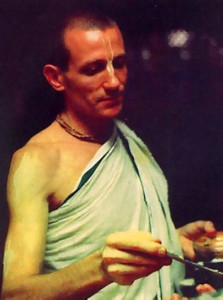
to worshipers.
My husband and I met John about a year and a half later. By coincidence the three of us had moved into the Calcutta Hare Krsna temple around the same time—July 1971. Everyone liked the affable, unassuming newcomer named John, who by then had traveled the length and breadth of the Indian subcontinent. My first service in the temple was to oversee the publication of a book honoring His Divine Grace A.C. Bhaktivedanta Swami Prabhupada, the founder and spiritual master of the International Society for Krishna Consciousness (ISKCON). September 1 was the anniversary of Srila Prabhupada’s appearance day, and all the devotees were writing appreciations of him. John wrote,
I left home for the holy land of India in search of the truth through spiritual knowledge. From the Himalayas to Cape Comorin I traveled, meeting sadhu and saint. Is my search in vain? Am I looking for something beyond God? For still I am not satisfied.
The devotees of Krsna showed me a version of the Bhagavad-gita by their master, A.C. Bhaktivedanta Swami Prabhupada. It was called “as it is,” which was the way I wanted to hear it.
I opened the pages, and before my eyes there it was, as it is, as it always was, God, Krsna. Not shapeless, but God with a form, and a beautiful form at that. A form which I could give all my love to and feel that it was not going into an endless, empty void and soon exhausting me of love, but instead it was going to a personal God. Not only was He accepting my love, but also replenishing it a thousand times more.
A thousand salutations at the lotus feet of His Divine Grace A.C. Bhaktivedanta Swami Prabhupada. (When will I be blessed by bowing my head beneath your holy feet?)
A thousand million salutations at the lotus feet of Lord Caitanya for starting the sankirtana movement.
A thousand million million salutations at the lotus feet of my dearest Lordships, Sri Sri Radha and Krsna.
John Prabhu
ISKCON Calcutta
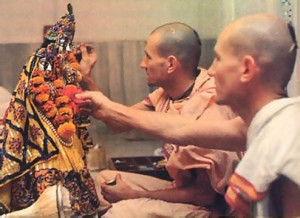
John told me that during his search in India he’d been influenced by impersonalists who led him to believe that the Absolute Truth was ultimately formless and without senses. Following that lonely path, he had tried to cut out all relationships. (Sometimes he had even been unable to bear to be with his twin brother, Roy, who was traveling with him.) After a year, all he had gained was a cold, hard heart, and in frustration he had finally given up his search. Then just two or three days later, he had met the devotees.
“From that I realized that by my own endeavor I could never understand God,” he said. “Only when I accepted guidance from a pure devotee did God reveal Himself. As soon as I read the books of Srila Prabhupada, he broke all my ice, all my rigidness and speculation, and instead he showed me the beautiful person, Krsna. When you understand the supreme person, then there’s love and reciprocation, sharing between others, and you become joyful.”
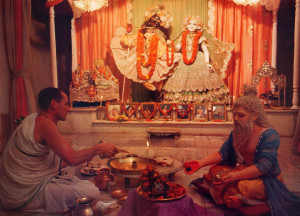
In October John’s wish was fulfilled. Srila Prabhupada came to Calcutta, and not only did John bow his head at Srila Prabhupada’s feet, but he also heard him lecture, talked with him personally, and, in the beginning of November, received initiation from him. Srila Prabhupada gave John the name Jananivasa dasa, meaning “the servant of God, who lives in everyone’s heart.”
At that time the devotees were holding a festival in Calcutta’s Desha Priya Park. Srila Prabhupada was speaking every morning and evening to a crowd of thousands (on the weekend, ten thousand), and during the day the devotees were chanting Hare Krsna, singing devotional songs, and performing ceremonies of formal worship of the Deities of Radha-Madhava.

Madhava is a name for Krsna meaning “He who surpasses the sweetness of honey,” and Radha means “She who worships Krsna best.” Radha is the Lord’s eternal consort. These eighteen-inch, effulgent brass Deities were presiding over the festival from Their altar in the center of the festival stage. Along with the pujari (priest), Jananivasa slept near the Deities to guard Them at night, and during the week-long festival he assisted the pujari by collecting flowers and leaves to decorate Radha-Madhava’s altar.
In the Bhagavad-gita Srila Prabhupada explains that the Absolute Truth may be worshiped with or without attributes. As the Deity in the temple. He is worshiped in His original, personal form, with attributes. But the form of the Lord, though represented by a statue made of such material substances as metal or stone, is not actually material.
To illustrate this point, Srila Prabhupada gives the analogy of a mailbox. We may find a mailbox on the street, and if we post our letters in that box, they will naturally go to their destination without difficulty. But any old box, or an imitation not authorized by the post office, will not do the work. Similarly, God has an authorized representation in His Deity form, who is an incarnation of God and who will accept the devotee’s sincere service. Although God is unknowable and unlimited. He mercifully appears in a form just suitable to our vision, in the form of the Deity. So the Deity is not an idol but the all-spiritual form of the Lord Himself. That is the all-powerful nature of the Lord.
In March 1972 Their Lordships Sri Sri Radha-Madhava, Srila Prabhupada, and twenty devotees, including my husband and myself, went to Mayapur. This rural village, located on the bank of the Ganges ninety miles north of Calcutta, is Lord Caitanya’s birthplace. Jananivasa had already moved to ISKCON’s recently acquired land in that open, flat farming area, where all of us, along with Srila Prabhupada, celebrated the appearance anniversary of Lord Caitanya.
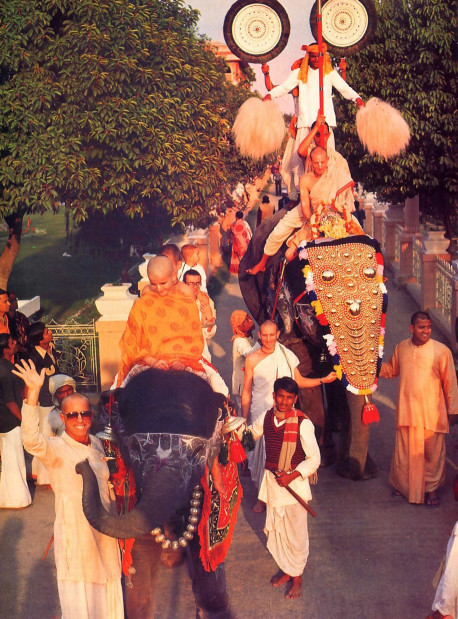
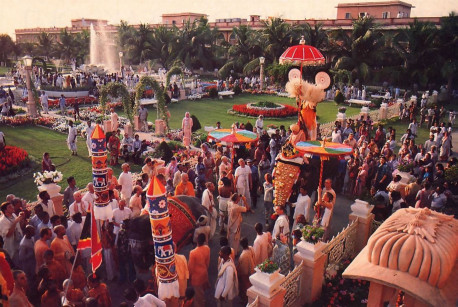
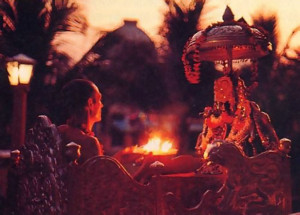
The beautiful Deities of Sri Sri Radha-Madhava were to reside in the peaceful, spiritual atmosphere of Mayapur, presiding over our fledgling project, which was destined to become the world headquarters of ISKCON. Twenty-eight-year-old Jananivasa was becoming increasingly attracted to the beautiful forms of Radha-Madhava. He felt that serving Them directly was an ideal way to become Krsna conscious, and within his mind he prayed, “My dear Radha-Madhava, please allow me to stay here and serve You twenty-four hours a day for as many days as I live. Please take over my life and guide me.”
* * *
In the years that followed, my husband and I regularly returned to Mayapur for the annual festival on Lord Caitanya’s appearance day, and Jananivasa was always there, as he had been throughout the year, devotedly serving Sri Sri Radha-Madhava by bathing Them, dressing Them, offering Them delicious meals throughout the day, and so on. Then in 1975, suddenly (so it seemed to me) there were two Jananivasas: his identical twin brother (now named Pankajanghri dasa) had joined him in the worship of Radha-Madhava after being initiated by Srila Prabhupada in England. (Jananivasa started wearing white clothes and his brother saffron, just so we could tell them apart.) Srila Prabhupada told one of his Mayapur managers, “I have noticed those two brothers. They are wonderful devotees. They never speak nonsense, they’re gentle, and they’re always meditating on Sri Sri Radha-Madhava.”
Jananivasa told me about a conversation he had had in the temple with a middle-aged Bengali guest who had asked him, “Are Radha-Madhava made of brass or gold?”
“Well, what are you made of?” Jananivasa replied.
After a pause, the gentleman answered, “Flesh and blood.”
Jananivasa told him, “As long as you think you’re made of flesh and blood, then you’ll think the Deity is made of one metal or another. But if you can understand that you’re not the body, that you’re spirit soul, and also that the soul is part and parcel of God, then you’ll understand that you’re of the same nature as Krsna.”
The man wasn’t sure that he had understood, so Jananivasa continued, “Do you accept that God is in your heart?”
“Yes.”
“So what’s He made of there, brass or gold?”
The man didn’t know.
“On the basis of the revealed scriptures,” Jananivasa said, “we can understand that God’s form is eternal and full of bliss and knowledge. That form, which is present in the heart of every living entity, is made of pure spirit, and that is what the Deity in the temple is also made of. You can’t see the Deity in your heart,” he explained as the gentleman nodded in agreement, “you don’t know who He is. So the Lord comes in a form you can see. Radha-Madhava appear to be material, but They are purely spiritual, and to the extent that you realize your nature is spiritual, to that extent you will understand that Krsna Himself is personally on the altar.”
The last time I met Jananivasa, it had been more than thirteen years since he first set foot in the holy land of Mayapur. In his usual thoughtful and unhurried manner, he attributed his steadfast service to the faith and conviction he got by reading Srila Prabhupada’s books. Before Jananivasa became a devotee, he had been sincerely looking for the truth, but he’d been plagued with doubts and confusion. Prabhupada had answered Jananivasa’s questions and cleared away his doubts as no one else had. So Jananivasa had embraced Krsna consciousness with heart and soul. “When a person comes in touch with perfect knowledge, he understands that he’s an eternal servant of God’, he’s subordinate to God,” Jananivasa said. “Then he asks God to engage him in His service. That’s the meaning of the maha-mantra we chant daily: ‘O my Lord, please engage me in Your service.'”
When John had offered a prayer in the Blue Mosque, he had asked God just for “a sign.” But eventually he got many signs. He met the Lord’s pure devotee, he heard the Lord’s words in the revealed scriptures, he began chanting the Lord’s holy names, and he became dedicated to His service. And Jananivasa’s undeviating determination and growing enthusiasm for that devotional service are a sustained sign from God of His divine presence.
Toward the end of our conversation, Jananivasa said, “You should do an article a year from now. Then the temple extension will be finished, and we’ll be installing the eight gopis [Radha-Madhava’s personal and most intimate associates]. After that, I’m planning to hold a festival each day of the year for the pleasure of Radha-Madhava, Srila Prabhupada, and all the devotees and guests. We’ll make it so wonderful that anyone who comes will forget his material problems and become absorbed in the Lord’s pastimes. We can even have several festivals going on simultaneously—a swing festival, a procession, water pastimes, feasting …”

Leave a Reply